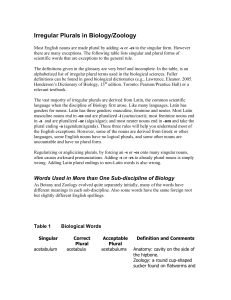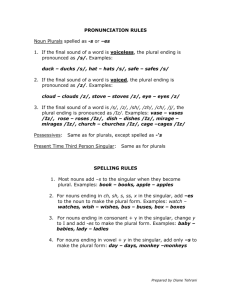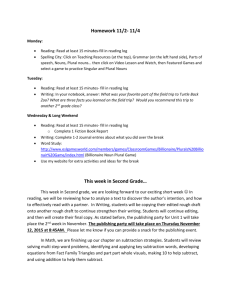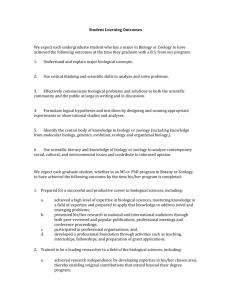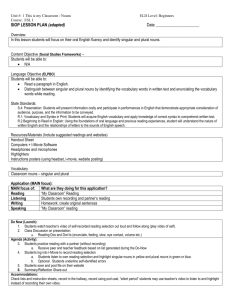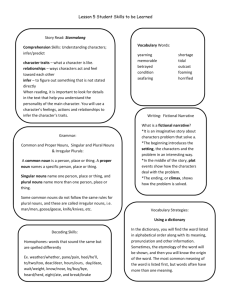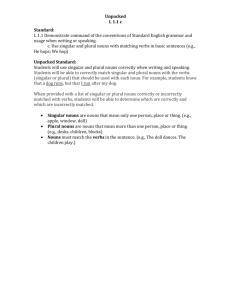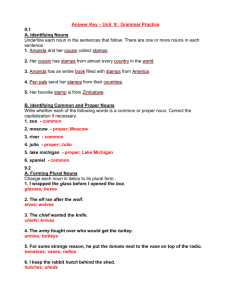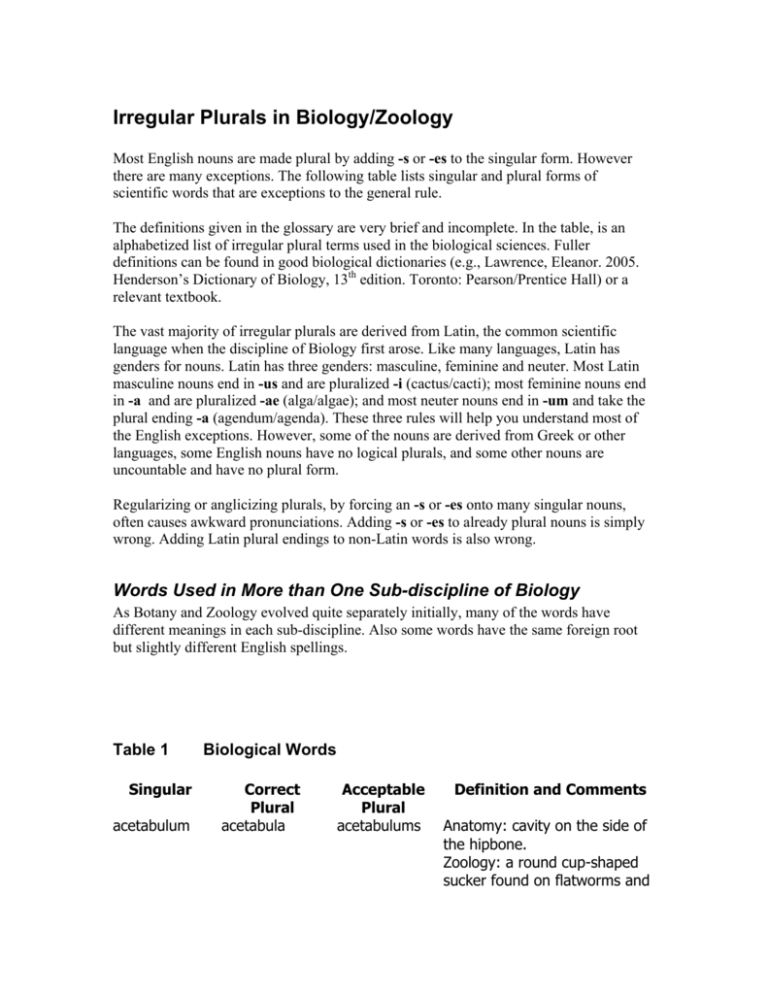
Irregular Plurals in Biology/Zoology
Most English nouns are made plural by adding -s or -es to the singular form. However
there are many exceptions. The following table lists singular and plural forms of
scientific words that are exceptions to the general rule.
The definitions given in the glossary are very brief and incomplete. In the table, is an
alphabetized list of irregular plural terms used in the biological sciences. Fuller
definitions can be found in good biological dictionaries (e.g., Lawrence, Eleanor. 2005.
Henderson’s Dictionary of Biology, 13th edition. Toronto: Pearson/Prentice Hall) or a
relevant textbook.
The vast majority of irregular plurals are derived from Latin, the common scientific
language when the discipline of Biology first arose. Like many languages, Latin has
genders for nouns. Latin has three genders: masculine, feminine and neuter. Most Latin
masculine nouns end in -us and are pluralized -i (cactus/cacti); most feminine nouns end
in -a and are pluralized -ae (alga/algae); and most neuter nouns end in -um and take the
plural ending -a (agendum/agenda). These three rules will help you understand most of
the English exceptions. However, some of the nouns are derived from Greek or other
languages, some English nouns have no logical plurals, and some other nouns are
uncountable and have no plural form.
Regularizing or anglicizing plurals, by forcing an -s or -es onto many singular nouns,
often causes awkward pronunciations. Adding -s or -es to already plural nouns is simply
wrong. Adding Latin plural endings to non-Latin words is also wrong.
Words Used in More than One Sub-discipline of Biology
As Botany and Zoology evolved quite separately initially, many of the words have
different meanings in each sub-discipline. Also some words have the same foreign root
but slightly different English spellings.
Table 1
Singular
acetabulum
Biological Words
Correct
Plural
acetabula
Acceptable
Plural
acetabulums
Definition and Comments
Anatomy: cavity on the side of
the hipbone.
Zoology: a round cup-shaped
sucker found on flatworms and
acinus
acini
alga
algae
alveolus
alveoli
amnion
amnia
amnions
ampulla
androecium
angiosperm
ampullae
androecia
angiospermae
ampullas
antheridium
antheridia
antrum
aorta
antra
aortae
archegonium
archegonia
areola or
areole
areolae
areolas /
areoles
atrium
atria
atriums
bacillus
bacilli
bacterium
(one cell or
one species)
bronchus
bacteria (more
than one cell
or species)
bronchi
bursa
bursae
angiosperms
aortas
bursas
mollusks; thoracic cavity of
insects in which a leg is
inserted.
tiny thin-walled air sac found in
large numbers in each lung
aquatic non-vascular
photosynthesizing organism;
formerly regarded as plants
tiny thin-walled air sac found in
large numbers in each lung
the inner membranes enclosing
the embryo of a bird, reptile, or
mammal
a small container
male part of flowers
vascular plants with covered
seeds
A reproductive cell containing
male gametes in algae and
fungi. In liverworts, mosses and
ferns, it is multicellular.
cavity within a bone
large blood vessel leaving the
heart
female organ in primitive pants
(mosses, liverworts, ferns, etc.)
Botany: space surrounded by
hairs or thorns, small area of
leaf mesophyll surrounded by
veins. Zoology: circular
pigmented area around the
nipple of certain mammals, part
of eye iris, small pit.
open chamber, especially of the
heart
aerobic, rod-shaped, sporeproducing bacterium
microscopic organisms without
a nucleus
tube leading from the windpipe
to a lung
a fluid-filled sac that reduces
friction around joints
cactus
cacti
cactuses
calyx
caryopsis
cava
cecum
calyces
caryopses/
caryopsides
cavae
ceca
cerebellum
cerebella
cerebellums
cerebrum
cervix
cerebra
cervices
cerebrums
cervixes
chiasma/
chiasmata
cilium
cilia
cisterna
clitoris
cloaca
cisternae
clitorides
cloacae
coccus
coccus
concha
cocci
cocci
conchae
corolla
corollae
corollas
corona
corpus
coronae
corpora
coronas
cortex
cortices
cortex
cortices
crista
cristae
clitorises
cloacas
succulent dicot plants adapted
for arid regions greatly modified
leaves; members of the family
Cactaceae
collective term for sepals
a seed-like dry fruit containing
a single seed
the largest vein in vertebates
pouch in which the large
intestine begins
the part of the brain located
directly behind the cerebrum
the front part of the brain
body part that resembles a
neck in shape or function
Anatomy: any crossing over of
biological tissue. Genetics: the
point at which two chromatids
join during fusion and exchange
of genetic material.
a short thread-like appendage
of certain cells
cavity containing fluid.
female erectile tissue
terminal region of the gut in
reptiles, amphibians, birds, and
many fish as well as in some
invertebrates
circular-shaped bacteria
circular shaped bacteria
part of the body shaped like a
conch shell
collective term for petals of a
flower
a crown-like structure
body of an organism; a
collection (body) of writings
tissue in plant stems and roots
between epidermis and the
central core
Anatomy: outer layer of a solid
organ or part of the body
Anatomy: crest or ridge, the
border of a bone
culm
decidua
culmina
deciduae
culms
edema
edemata
edema
edemata
endocardium
endocardia
endoplasmic
reticulum
endoplasmic
reticula
endothelium
endothelia
epididymis
epithelium
epididymides
epithelia
esophagus
esophagi
fascia
fasciae
fascias
fauna
faunae
faunas
flagellum
flagella
flagellums
flora
florae
floras
folium
foramen
folia
foramina
foramens
fornix
fornices
fossa
fossae
frenulum
frenula
epitheliums
Cell biol.: fold in the inner
membrane of a mitochondrion
stem or straw of grasses
specialized part of the mucous
membrane that lines the womb
during pregnancy
abnormal swelling in a plant
caused by a buildup of excess
water
Med.: abnormal buildup of
serous fluid between tissue
cells
thin membrane lining the heart
cavities
Internal membranes of cells;
often abbreviated as ER
layer of cells that lines the
inside of certain body cavities
coiled tube that stores sperm
a thin layer of tightly packed
cells lining internal cavities,
covering exposed bodily
surfaces
the passage between the throat
and the stomach
sheet of connective tissue
covering parts of the body
collective tern for animals in an
area
a long lash-like appendage of
certain cells
collective term for plants in an
area
natural opening through bone
or cavity
Anatomy: structure or fold in
the shape of an arch
hollow, pit, or groove in a part
of the body
small fold of skin or membrane
that limits the movement of an
organ
fruit
fruit
fungus
fungi
ganglion
gastrula
gemma
genitalium
genus
gingiva
glans
glomerulus
Golgi body
gymnosperm
gynoecium
gyrus
haustorium
herbarium
hilum or hilus
hypha
ileum
indusium
fruits (when
concerning
several kinds
or species)
funguses
mature ovary containing seeds
group of organisms without
chlorophyll that obtain nutrients
from organic matter
ganglia
ganglions
dense cluster of nerve cells
gastrulae
stage in embryonic
development
gemmae
a budlike, asexual structure
genitalia
genitals
external components of
reproductive organs
genera
a grouping above species level
gingivae
gum around the roots of the
teeth
glandes
erectile tissue of a penis and
the tip of clitoris
glomeruli
cluster of blood vessels, nerve
fibers, or other cells; cluster of
capillaries in the cortex of a
kidney
Golgi bodies
organelles of cells
gymnospermae gymnosperms vascular plants with naked
seeds
gynoecia
female part of flowers
gyri
rounded ridges on the outer
layer of the brain
haustoria
“root” of a parasitic plant that
penetrates the host
herbaria
herbariums
collection of preserved plants
and plant-like organisms
hila or hili
Botany: scar on a seed of a
plant where it was attached to
the ovary; nucleus of a starch
grain. Zoology: opening or
depression where blood vessels
and nerves enter or leave an
organ.
hyphae
threadlike part of the vegetative
portion of a fungus
ilea
the third and lowest portion of
the small intestine
indusia
paper-like covering of fern
infundibulum
infundibula
iris
irides
irises
labellum
labium
labelli
labia
labiums
lacuna
lacunae
lacunas
lamella
lamina
lamellae
laminae
laminas
larva
larvae
larvas
larynx
larynges
larynxes
leaf
leaves
lemma
loculus
lemmae
loculi
lumen
lumina
lumens
lumen
lumina
lumens
macula
maculae
maxilla
maxillae
maxillas
sporangia
funnel-shaped opening,
passage, or structure in
vertebrates
structure within the vertebrate
eye
lip of an orchid flower
lip-shaped structure. Botany:
the lower lip of the corolla of a
labiate flower. Zoology:
hindmost mouthpart of an
insect.; inner margin of the
opening of a snail shell; any of
the folds that surround
mammalian female genitalia.
small pit or cavity in bone or
cartilage
layered structures
thin layer of cell, scales or
plates. Botany: blade of leaf.
Zoology: layer of cells in brain;
in hoofed mammals, layers of
sensitive tissue inside the hard
exterior of the hoof.
a stage of an insect or other
arthropod after leaving the egg
cartilaginous part of the
respiratory tract
flattened or needle-like plant
structure; primary site of
photosynthesis
the outermost bract of grasses
cavity or opening in the ovary
of a flower
space inside any tubular
structure in a body
empty space, e.g. a cavity
within a plant cell wall
small pigmented spot on the
skin , small yellowish spot in
the middle of the retina of an
eye
upper jawbone in vertebrates,
mouthpart of some arthropods
meatus
mediastinum
meatus
mediastina
medulla
medullae
medusa
meninx
medusae
meninges
meatuses
medusas
mitochondrion mitochondria
monochasium
monochasia
mucosa
mucosae
mycelium
mycelia
myocardium
neuologium
myocardia
neuroglia
nucleolus
nucleoli
nucleus
nuclei
ochrea
ochreae
octopus or
octopod
Octopuses or
octopods
oogonium
oogonia
operculum
opercula
os
ora
octopi
operculums
a body opening
Mammals: in the chest between
the lungs; contains the heart
and trachea
the innermost area of a part or
organ of an animal or plant
jellyfish form
membranes that surround and
protect the brain and the spinal
cord
cellular organelles outside a
nucleus
branched flowerhead with one
branch each
wall of tubular structure
containing mucous-secreting
cells
a collection of hyphae of a
fungus
thick muscular wall of the heart
supporting tissue and fibers
that nourishes nerve cells in the
central nervous system
region of the nucleus where
RNA is made
DNA of cells enclosed by a
membrane
sheath around base of grass
internode
marine mollusk with eight
tentacles. Octopus is derived
from Greek, so is technically
more accurate.
Octopuses is acceptable for
several members of the genus
Octopus
reproductive cell containing an
egg in algae and fungi
lid or covering, of a pitcher
plant or a moss capsule;
closure of a snail’s shell, fish’s
gill covering
a mouth or mouth-like opening
of an organism
os
ovule
ossa
ovules
ovum
ova
palea
papilla
paleae
papillae
pappus
pappi
patella
pelvis
patellae
pelves
patellas
penis
penes
penises
pericardium
pericardia
pericardiums
peritoneum
peritonea
peritoneums
pharynx
phylum
pharynges
phyla
phylums
pilus
pili
pilus
pili
pinna
pinnae
pinna
pinnae
pinnas
placenta
placenta
placentae
placentae
placentas
placentas
pleura
pleurae
pleuras
pollinium
protozoon;
protozoan
pollinia
protozoa;
protozoans
ovums
a bone
In an ovary, a structure
containing an egg. On
fertilization, ovule matures into
a seed. Not ovuli
female reproductive cell; an
egg
inner bract of a grass flower
small nipple-shaped
protuberance
hair or bristle at apex of a
floret, e.g. on dandelion
“seeds”
kneecap
basin- or cup-shaped
anatomical cavity or the bones
that comprise it
male organ that transfers
sperm to female
fibrous membrane surrounding
the heart
smooth transparent membrane
that lines the abdomen
the throat
a large group of organisms;
often capitalized
bacterial appendage for
adhesion
bacterial appendage for
adhesion
a primary division of a leaf or
frond
feather, wing, or other similarly
shaped body part or appendage
tissue bearing ovules in plants
vascular organ that develops
inside the uterus of most
pregnant mammals
thin transparent membrane
covering the lungs
a sticky pollen-bearing structure
single-celled organism that can
move and feed on organic
compounds
pubis
pubes
pudendum
pupa
pudenda
pupae
rachilla
ramus
rectum
rachillae
rami
recta
rectus
reticulum
recti
reticula
rhizome
rumen
rhizomata
rumina
rhizomes
rumens
scrotum
scrota
scrotums
septum
septa
serosa
serum
sorus
serosae
sera
sori
spadix
spadices
species
species
sperm
sperm
sporangium
sporangia
sternum
sterna
sternums
stoma
stomata
stomas
rectums
serums
sperms
(when
concerning
several kinds
or species)
joined pair of bones comprising
the lower front of the hipbone
human external genital organs
insect stage between larva and
adult
axis of a grass inflorescense
branches of a forked structure
the lower part of the large
intestine
any straight muscle
the second stomach
compartment in ruminants
a root-like fleshy stem
the first stomach compartment
in ruminants
external pouch of skin and
muscle containing the testes in
mammals.
membrane dividing something
into two or more cavities
serous membrane
clear fluid of blood without cells
a collection of sporangia in
ferns
Botany: a fleshy spike of
flowers. Zoology: part of the
developing mouth region of
some cnidarians; amalgamation
of the tentacles of certain
cephalopods.
“specie” has been used by
some as a singular form of
species
male reproductive
cells/structures; component of
semen
a sac-like structure containing
spores in plants
the breastbone; chitinous
ventral plate of an arthropod
small opening. Botany: a pore
of a leaf or stem. Zoology: part
strobilia
strobiliae
strobilus
strobili
stroma
stromata
sulcus
sulci
taxon
testa
testis
taxa
testae
testes
taxons
thallus
thalli
thalluses
thorax
thoraces
thoraxes
tibia
tibiae
tibias
torus
tori
trachea
tracheae
tunica
tunicae
ulna
ulnae
tracheas
ulnas
of alimentary canal of
nematodes; opening made
surgically.
proglottids of a tape worm,
polyp form that gives rise to
jellyfish medusae
a collection of sporophylls into a
cone as in club-moss or
gymnosperms
Cell biology: fluid-filled interior
of a chloroplast containing
enzymes. Mycology: fungal cells
and host cells on which a
spore-bearing structure may
form. Zoology: vascular tissue
in which ovarian follicles are
embedded.
a shallow groove or depression
on the surface of the brain
a category in a classification
the outer part of a seed
male reproductive gland;
synonym of testicle
a plant body without a true
root, stem, or leaves
part of body between the neck
and abdomen, containing the
heart and lungs
a bone of the lower hind leg;
the shin bone
receptacle or enlarged tip of a
stem on which flowers are
borne.
Botany: type of waterconducting plant tissue.
Zoology: tube of insects and
related air-breathing arthropods
through which air is drawn into
the body
Botany: dry covering around a
bulb or corm. Zoology: layer of
tissue that covers or lines a
body part or organ
one of two bones in the fore
urethra
urethrae
urethras
uvula
uvulae
uvulas
vertebra
vertebrae
vertebras
vibrisa
vibrissae
villus
virus
viscerum
villi
viri
viscera
viruses
vulva
vulvae
vulvas
Credits:
Contributing authors:
Dr. Robert Holmberg
Dr. T.S. (Lochan) Bahshi (Professor Emiritus)
Dr. John Ulici-Petrut
Dr. Shauna Reckseidler-Zenteno
Robert Carmichael
Editors:
Veronica Baig and Linda McCloud-Bondoc
leg/arm
tube in vertebrates that carries
urine from the bladder out of
the body
V-shaped extension of the soft
palate
bones of the spinal column /
backbone
mammals: hair or whisker that
vibrates when touched; birds: a
bristle or hair-like feather, near
the beak, especially of insecteating birds
intestinal structure
non-cellular parasite of cells
the internal organs of an
animal, especially of the
abdomen; singular form not
usually used
external female genitalia

